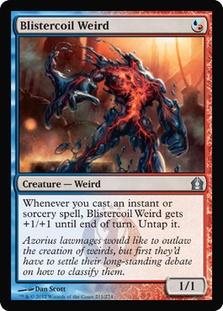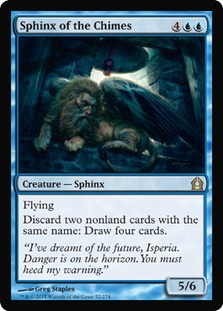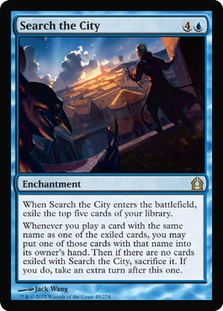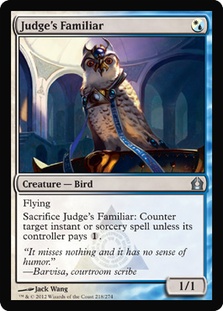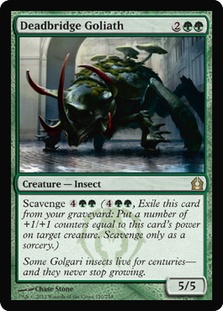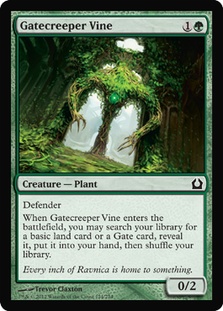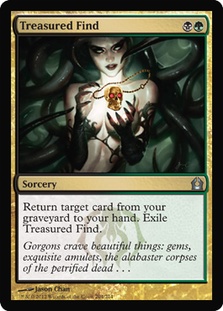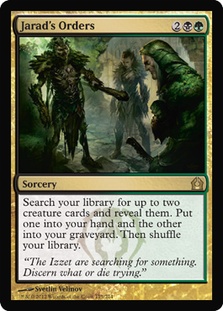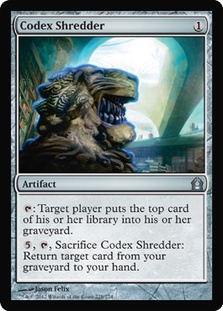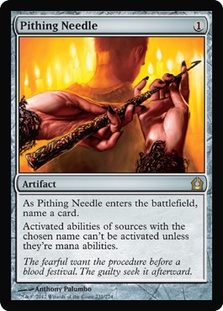Return to Ravnica is one of the most anticipated sets of all-time. It brings with it one of the most anticipated rotations of all-time. It has cards for every format, but Standard, in particular, is radically different today than it was yesterday.
Monday, we talked about updates to existing strategies. Wednesday, we talked about new strategies possible with Return to Ravnica. Today, I’d like to talk about the cards we haven’t discussed so far this week. While a deck-by-deck format worked better for Parts 1 and 2, today I’d like to tackle the remaining cards by color.
Before we jump in, I would like to add a couple of comments on Part 2. To begin with, thank you to everyone for bringing the typo on Pillar of Flame + Dryad Militant to our attention. As is obvious from the context, it is invaluable that Dryad Militant does exile Pillar of Flame, interfering with Snapcaster Mage. Unfortunately, an inappropriately placed “not” is a most insidious typo.
Additionally, everyone that pointed out Veilborn Ghoul’s positive synergy with Pack Rats and Lotleth Troll, as well as Liliana of the Veil, you are absolutely correct. This is a fairly exciting interaction to be sure, as these decks would love a Squee even if you only get him back some of the time.
Ok, I rolled a five-sided die to determine which color to do first. The winner?
Red
I covered a lot of the Mono Red sort of red cards a couple weeks ago here. For the lazy, here are the cliff notes:
Ash Zealot – Great card, great rate, though certainly not the second coming of Figure of Destiny. The best two-drop red has though.
Rakdos Cackler – Exactly what red was looking for. This guy isn’t as good as Gravecrawler or even Diregraf Ghoul, but historically red has appreciated two-power one-drops more than anyone. As for his utility in black decks, they wanted another one-drop as bad as red did, so he is just a hit even if his rate is barely Savannah Lions.
Rakdos Shred-Freak – This one is certainly a lot more debatable than Ash Zealot. I happen to be a haste-freak and prefer him to Mogg Flunkies or Gore-House Chainwalker, though those are both reasonable options to be sure. He is also fine in black decks, but that is mostly a function of the mediocrity of two-drops they have been used to. When your bar is Walking Corpse and Blood Artist, it doesn’t take much to impress.
Electrickery – An underrated cheap removal spell that has me smiling at how quickly we can forget the lessons of Gut Shot. Yeah, yeah, obviously Gut Shot was a zero-cost blue spell; I’m not even talking rate. I just mean cheap burn spells that can’t hit players can still be good. Gut Shot could hit players, but seriously, it was just one damage. That is a nice option, of course, but it is not like Electrickery doesn’t provide some nice options from time to time.
Continuing to compare it to Gut Shot isn’t really fair since Gut Shot wasn’t played in red decks aside from a few that actually wanted to go to the dome with it on turn 2 once in a while. Let’s compare it to Shock.
Compared to Shock, it kills maybe half as many creatures and can’t go to the face. In exchange, you get the option to kick it for just two mana to Simoon.
Wait. What?
Simoon was a tournament winner, was much harder to cast, and could actually be good today. Electrickery is an easier to cast Simoon that also has the option to be used as a one-mana removal spell thrown in for free!
Besides, I gotta be honest with you. We would settle for a lot less than Shock. Shock itself would be a dream come true at this point. All that action rotated. You got Pillar of Flame, and then you start looking at the expensive options.
I am not sure how many Electrickery you can actually play maindeck these days, but honestly, drawing the second one is often way better than the first. Deal two to everything and you are building your own Bonfire.
I await Patrick Sullivan red list, but in the meantime, here’s what I’d like to start with:
Creatures (22)
Lands (22)
Spells (16)

Maybe four Electrickery is too many, but I kind of want the double trick draw, plus I wouldn’t be surprised if the interaction with Ash Zealot comes up more than one would expect.
Blistercoil Weird – I preferred Stonewright with less burn spells, but once we are up to around sixteen burn spells, with most of them cheap, I think this guy will do a passable enough Jackal Pup impression to give him an audition. I wouldn’t be surprised if the correct strategy is to max on this guy and Shred-Freak and trim a Hellrider and a Hellion Crucible.
Nivmagus Elemental – Ok, this one is definitely going to take some experimenting with. On the surface, it’s one of those “Why would I want to do this?” types of cards, but I dunno, man. You can turn your extra Electrickery into instant speed Giant Strengths for just one mana. That is pretty sick. I could totally see cutting the four Hellriders and three Crucibles for another Weird, four Nivmagus, another two-drop, and maybe a 20th Mountain. Of course, once you go that far you might want Mogg Flunkies or Gore-House Chainwalker instead of Shred-Freak. As a matter of fact, you might even want Furor of the Bitten.
Creatures (22)
- 4 Steamcore Weird
- 4 Stromkirk Noble
- 2 Rakdos Shred-Freak
- 4 Nivmagus Elemental
- 4 Ash Zealot
- 4 Rakdos Cackler
Lands (19)
- 19 Mountain
Spells (19)

Annihilating Fire – I’d love to like this card more than just a friend, but there are just so many other three-cost burn spells I like spending time with more. I like exiling Gravecrawler and undying creatures as much as the next guy, but a three-mana instant is a far cry from a one-mana sorcery.
Does it do the job? Well, sort of. I mean, it does exile stuff, so if you just want more of that it can be bought, and that’s not terrible. It’s not even just that you have options like Brimstone Volley and Flames of the Firebrand to compete with or the double red in its cost. It’s that it leaves you holding the bag against regenerators, even though it feels like it should trump them, to say nothing of Thragtusk, which it should totally be able to beat.
Bloodfray Giant – Man, we would have killed for this thing in the nineties. These days, it is a third pick Limited card? Though, I guess to be fair, we wouldn’t have been caught dead casting Unsummon, so there you go.
Fact: Hellrider still hits like a bag of trucks.
Vandalblast – Some cards have such deceptive appearances, hiding layers of subtleties and rich, complex puzzles to slowly unravel over time.
This card is not that. It is a powerful sideboard option for when you’d like a Shatterstorm, but sometimes have to settle for Shatter due to how fast the opposing deck is. Without question, this card is an absolute monster against decks like Affinity or Stax. The question is do you have the sideboard space to get points against these people? If so, this card is tops.
Blue
First of all, the blue cards that have not already been discussed in the previous two installments are a bit more diverse in their potential applications than the red cards.
Second of all, while I have certainly written about Jace, Architect of Thought a fair bit (every week, in fact), I will be continuing to write about this guy.
Jace 4.0 is shockingly powerful.
For a breakdown of why (i.e., Jace is a Fact or Fiction where each pile is down a card but has a Jace thrown in) and more Jace decks, check here.
2.0 > 4.0 > 1.0 > 3.0
Sphinx of the Chimes – “It’s no Consecrated Sphinx.” -everybody everywhere
Of course, to be fair…
“Consecrated Sphinx is going to be a defining creature in Standard.” -nobody anywhere
How many cards do you have to draw before Sphinx of the Chimes is good enough? After all, Fat Moti just isn’t as heavy a hitter as he was when I was your age (and had to walk ten miles to Magic tournaments, barefoot, in the snow, uphill both ways, on broken glass, on my way from the coal mine where I worked 23 and a half hours a day to pay for the boosters that didn’t even contain mythic rares…)
Let’s start with one activation. Is that enough? Discard two cards to draw four? That is effectively draw two. Would I play a 5/6 flier for six that draws two cards?
Is this a giant joke?
I would freaking kill for that card. Consecrated Sphinx is fun and all, but how many cards do you really need?
So, a couple hurdles. First, what percentage of the time are you going to have a match to discard immediately? It’s probably not that high, right?
Next problem: we aren’t just discarding two—they have to be a match, and as I have recently learned, we can’t even discard land.
Here is the real issue. Have you made a control deck recently? How many four-ofs do you play? These days, control decks love playing a great diversity of cards of all types. That makes it really hard to make a match.
When was the last time you really wanted to play Mono-Blue in Standard?
Ok, this list is probably terrible, but you get the idea. We are going to need some sweet technology to avoid getting run over by Zombies, and I have a feeling that eight Unsummons is too many. I’m not sure where we are going to find the missing speed while preserving the mono-Islands plan, but maybe it’s out there.
Also bad, but it is interesting to consider what Sphinx of the Chimes might incentivize us to do. You don’t have to play mono-blue, of course.
Maybe something like:
Creatures (8)
Planeswalkers (5)
Lands (25)
Spells (22)

We might need some Detention Spheres, but this is a start that looks a helluva lot better than the previous two. Point is, Sphinx of the Chimes actually seems kind of sweet if you can handle a deck with this many four-ofs. I am actually medium shocked Michael J. Flores isn’t all over this one, as he is into that kind of hit.
Isperia, Supreme Judge – As for blue deck victory conditions, this one is tougher to evaluate. To begin with, his body is slightly awkward. Being front heavy implies a propensity to beatdown, which isn’t exactly plan A. To make matters worse, four toughness is supposed to be the line. Combine that with no comes into play ability and it is starting to look like the writing is on the wall.
The counterpoint?
Just imagine casting this and your opponent not having a removal spell.
Seriously, attacking grinds to a halt (assuming you aren’t dead on board). If there is one thing we have learned from Baneslayer Angel, it is that they don’t always have it. In fact, an awful lot of the time they don’t.
My snap judgment is that this isn’t where you want to be week 1, but I suspect his time will come (albeit in a somewhat niche capacity).
Search the City – This is pretty preposterous card text; let’s just get that out of the way. If I had to pick a card for “trying too hard to be a wacky build around,” I might have to give it to Search the City. The card appears on the surface to rest so heavily on how ridiculous it is supposed to read (not ridiculously powerful, just ridiculous). However, it might just redeem itself with actual good game play.
Five mana “do nothing” isn’t that exciting, but it is a queer sort of card drawer that eventually gives us a sweet late game. What is the value of those five extra cards over time? It is important to note that a reasonable percentage of the time, we will actually finish Searching the City a little ahead of schedule. Whenever we reveal two copies of the same card, we only need one more copy to trigger both since we can use the copy we draw from Search the City to trigger the second copy exiled by it.
Is it worth it as a card drawer, just playing it fair? With options like Jace, the Architect of Thought and Tamiyo, the Moon Sage, this is unlikely.
Can it be broken?
Well, in Standard, the easiest way I can think to set up the top of your library is Gravepurge. You still need to have dredged a fair bit to even set this nonsense up, but if you have, you can Gravepurge back more copies of two creatures you have in hand. That is a helluva lot of work, but it could be a thing.
If we want to cut all the way to the top, we can combine Search the City with Goblin Recruiter to rig it so we auto-win…
… Of course, we can also combine Kasimir the Lone Wolf with Goblin Recruiter to rig it so we auto-win.
This is such a wacky card with so much output that the super Johnnies of the world have at least a 5% chance of making a sick combo deck with it. However, at five mana it is far more likely to be a curiosity than anything else.
Judge’s Familiar – How good is Cursecatcher without the tribal synergies? Flying is nice, but I don’t really recall Cursecatcher ever seeing play without a lot of positive tribal interactions. That said, Spiketail Hatchling has actually seen a lot of play over the years, and this guy is way better. It is because of Spiketail Hatchling that I think this card will prove successful in powered formats (including Modern).
As for Standard, he certainly has chances, making it really uncomfortable for people relying on sweepers. Unfortunately (for the Bird), Standard is shaping up to be a format with a lot of creatures and a lot of cheap spells…plus most of the sweepers this could counter rotated out. The main one you’d want to hit with it, Supreme Verdict, is uncounterable. This is a good card and could find a home in Standard if things break right (people cast a lot of two- and three-mana sorceries without flashback early), but he is better in spell-heavy, mana-efficient formats.
Counterflux – Fine as a Cancel variant. Dissipate is a little better in general, but there is value to diversity and this one gains some utility if you expect to face countermagic. Amusingly, despite being a mediocre Cancel variant in Standard, it actually has passable chances in higher-powered formats just by virtue of being a far better Last Word that has anti-Storm implications among other tactical uses. Counter every storm copy and every one of mine is uncounterable? Interesting…
Epic Experiment – Despite some surface level similarities to Genesis Wave, this card is going to play out very differently. It isn’t even just the asymmetry between spells and permanents. Spells are so good, but the fact that you miss on land is actually really big.
It’s tempting, at first glance, to want to use all cheap spells. The thing is that you don’t want to Epic for two or three if you can help it. What you really want is the first Epic to be for at least four. This makes us want to include some four-drops in our list. Here is a first attempt:
Lands (24)
Spells (37)

This build plays a mediocre control game but tries to get ever-growing surges of card and tempo advantages from its Epic Experiments. The first one is typically just a value Experiment, but if you hit an Increasing Vengeance, you actually go pretty deep.
Ideally, we want to experiment for at least four to capitalize on Amass and Supreme Verdict. Once we have drawn a lot of cards and swept the board, we are looking to set up a game state where we can Epic Experiment for so much (and so many times) that we can Psychic Spiral our opponents to death.
Psychic Spiral is kind of an exciting kill card for combo decks outside of just Epic Experiment. It may look like a Traumatize on the surface, but it can actually kill people. It takes milling most of your deck to actually kill someone with one, but that isn’t that hard to do with cards like Mulch, Grisly Salvage, Forbidden Alchemy, Armored Skaab, Tracker’s Instincts, and so on. Even if you have just one in your deck, you can eventually find it and flash it back with a Snapcaster Mage. It gives you an alternative way to kill people besides just Laboratory Maniac that isn’t vulnerable to removal.
Alternatively, you can just run multiples because a second Spiral will generally kill most people if you are running the right self-mill cards. It is worth noting that graveyard hate hoses the Spiral much, much more than it hoses Laboratory Maniac.
As for Epic Experiment, an alternative route to go is to play a lot of mana acceleration, like Farseek and Ranger’s Path, to try to get up to eleven mana so that we can Epic for nine. Then, if we hit a Worldfire and a burn spell, we just win. Once we incorporate green, we might end up wanting Thragtusk. He is another brick for our Epic Experiment, but he does kill with Worldfire if you just cast them both in the right order.
Treasured Find is another interesting card to consider with Epic Experiment. It doesn’t get back the Epic Experiment on the stack, but it does give you a lot of great options to keep going. In this vein, it is interesting to consider Epic Experiment in Modern where you can actually reveal a Remand and bounce the Epic Experiment back to your hand. If you are playing a bunch of Rituals (maybe even Channel the Suns), you might be looking at a new Modern combo deck.
Epic Experiment keying off of casting cost is interesting with cards that have an unnaturally low printed cost. For instance, no matter what counting number you epic for, Ancestral Visions is castable if it is on top of your deck. Epic Experiment has better chances than most for turning into a sick combo deck, though the path to this deck is far from clear.
Goblin Electromancer – Since we didn’t talk about this guy in red, I suppose he falls under blue. This guy may be sized to die a fair bit, but he also isn’t exactly asking that big of an investment.
U/R is the default color combination for blue creature decks these days, so it isn’t like he doesn’t have a chance to make it big. The tricky part is actually that the color reduction doesn’t help with Pillar of Flame, Thought Scour, Unsummon, Izzet Charm, and so on. It is hard enough to find sorceries and instants we want to play at all. Trying to find a bunch with colorless costs involved is quite challenging.
To really get paid from the Electromancer, you want to have a pretty sizable number of “hits,” so maybe a Delver shell is the wrong angle. Then again, since they count double, maybe Desperate Ravings and Think Twice is enough?
Creatures (16)
Lands (22)
Spells (22)

Izzet Staticaster – While on the topic of U/R creatures, Izzet Staticaster is a pretty “different” one, mostly in that he is hardly a creature at all. Without the intrinsic ability to deal damage to players, Izzet Staticaster seems at first a sideboard card.
I’m not so sure. See, when I see this guy, he sure looks an awful lot like Cunning Sparkmage, a card that surprised a lot of people and dominated a lot of tournaments. Izzet Staticaster maybe not be able to hit players, but he does have the advantage of being able to sweep tokens (permanently), has flash, and is tougher to kill (as a three-butt is not inconsequential). What’s more, he combines with Electrickery for very powerful board sweeping.
Cunning Sparkmage certainly did not need Basilisk Collar to be good, but that was a powerful combination. Of course, we are not without a good deathtouch enabler ourselves. It is certainly more expensive and ambitious as far as colors are concerned, but Vault of the Archangel + Izzet Staticaster completely locks out almost every creature strategy if unmolested.
You had me at instant speed Tim with haste. That he sweeps and can actually block two-power creatures is just gravy. This card is kind of weird, but honestly, I don’t think they would have given it the three toughness (instead of one) unless it came up in development that he needed it to do what they wanted in tournament play (which implies that he was engineered for tournament play).
Green
Green has plenty of easy new gold cards, like Abrupt Decay, Lotleth Troll, Grisly Salvage, Vraska the Unseen, Dreg Mangler, Call of the Conclave, Armada Wurm, Selesnya Charm, and Guardian of the Grove; many of its mono-color cards are a bit weirder (and difficult to find proper homes for).
Axebane Guardian – Being a mana accelerator at all automatically warrants making the list of cards to consider. That said, this is a very modest rate assuming we are anchored in the world of Overgrown Battlement. Of course, that was a somewhat pushy rate and lived in a world with Wall of Omens. Axebane Guardian does make mana of any color, and a three-toughness creature can still block some things, so I wouldn’t write it off, yet. Fringe sounds about right.
Brushstrider – Look, we already had our chance to be excited about this sort of thing. Garruk’s Companion was way, way better and did relatively little. This guy is better than Grizzly Bears but is miles from the rate he needs to be good on his own.
Deadbridge Goliath – Deadbridge Goliath, on the other hand, is actually a pretty reasonable fellow. I definitely have a soft spot for four mana 5/5s, but this is a great time for them, given Mizzium Mortars and all. Besides, a lot of people are going to have trouble getting through this guy. That he also scavenges is what pushes him over the top. Six mana to put five +1/+1 counters on a creature may not sound that insane, but think of it like a flashback. Five counters isn’t that far off compared to a 5/5 body, and it is like they have haste.
The Goliath isn’t that fancy, but if you are in the market for a fatty, he’s got a respectable rate.
Gatekeeper Vine – Ok, first of all, it certainly isn’t Borderland Ranger if you just want a real body. However, compared to Sylvan Ranger, it has some advantages (beyond being legal). It fetches the Guildgates (which could make for some interesting mana bases). It also powers up our Axebane Guardian if we are into that sort of thing. It’s usually just going to chump, but honestly, Sylvan Ranger did too.
Verdict: Fringe role-player.
Deathrite Shaman — It’s always tougher to evaluate creatures that do something really new, and Deathrite Shaman is no exception. It is not that the output is novel—it’s that the input is novel (and so obviously contextual).
As a mana accelerator, this guy is nowhere near as reliable as Arbor Elf or Avacyn’s Pilgrim. That said, there is a real shortage of mana accelerators, so having access to another one is certainly very interesting. It’s important to note that he gives you mana of any color, while the other one-mana accelerators do not. This is particularly valuable when you consider what sorts of decks can actually get land into their graveyards to fuel him as a Birds of Paradise. Self-Mill decks can be just B/G (which works perfect for him), but they are often going to contain two or three other colors, which really appreciates having another five-color fixer.
A turn 1 Deathrite Shaman followed by a turn 2 Grisly Salvage or Tracker’s Instincts has us already ahead of the curve. We could even potentially use the mana that turn with Gravecrawler, Faithless Looting, Thought Scour, or another mana creature. Each turn after, however, having access to a Birds of Paradise is huge.
Deathrite Shaman is certainly not only a mana creature. In fact, many people won’t use this ability often (though it is worth remembering that you or your opponent’s Evolving Wilds can power him up, and in higher-powered formats, he can exile lands people are recurring like Wasteland).
Deathrite Shaman’s ability to exile sorceries and instants is yet another attack on Snapcaster Mage. It is very interesting that a Deathrite Shaman sitting in play basically locks out a Snapcaster Mage. Even if you want to put your opponent on a clock, it at least forces them to use Snapcaster at inopportune moments as well as denies the ability to flashback sorceries and counterspells.
This leads us to how aggressive Deathrite Shaman’s damage dealing capacity is. Against an awful lot of opponents, this guy is Grim Lavamancer to the dome. Even better, he disrupts their ability to use flashback. Two damage a turn is a lot from a one-drop, and he even has a second point of toughness to reduce the amount of Tragic Slips and Electrickery he falls for.
Deathrite Shaman’s ability to exile creatures has obvious applications against Gravecrawler, Geralf’s Messenger, and Strangleroot Geist, but it is also sometimes tactically valuable to just gain two life a turn. Besides, this card really is a giant kick in the pants to Reanimator.
The card is so hard to fully grasp at first glance that it will probably be slow to see wide-spread adoption, but the abilities are so good that I imagine this will show up in some maindecks as just a random good card (ala Grim Lavamancer in non-aggro decks), as an enabler for graveyard decks, as a sideboard card for a variety of people, and as a new “Hate Lion” for powered formats. The card does so many things that it will continue to surprise us with the wild tactics it enables.
Mana Bloom — I’m not sure, but I think this is card is only mediocre. It’s nice that it’s a five-color enabler, but we have a lot of better options like Farseek and Abundant Growth. It is an accelerator, so it definitely makes my list of cards of note, but it is a little clunky. If you play it on turn 2, you only get one shot before having to sink more mana into it. Beyond that, it could have been a Keyrune since it still only gives you one mana a turn.
I bet the Commander players love this type of thing, and Zvi might break it. But for now, my interests are elsewhere.
Worldspine Wurm – Natural Order, Dramatic Entrance, Through the Breach, etc. This guy is certainly fine as the 68th fatty to cheat into play, but he isn’t particularly novel or fun. I guess it could have been cool that he is a 15/15, but Emrakul has basically set a decade of coolness points on fire.
Treasured Find – How good is Regrowth? The only differences here are the slightly more restrictive cost and the exiling part. We don’t usually Regrowth Regrowths (this drawback mainly interferes with Snapcaster shenanigans), and once you are playing the right colors this is basically just Regrowth. All these observations say nothing about how good Regrowth actually is in a world without Ancestral Recalls and Time Walks.
Recollect is the closest comparison, and it has certainly seen some play but has generally been part of Gifts Ungiven packages or as a Regrowth that you could transmute for.
This brings us to the first and most obvious of Treasured Find’s abilities as a Gifts target. In Modern, it is not a new technique to Gifts for two cards you want and two Regrowths. Eternal Witness has classically been “the easy one” since she is such a better rate than any of the others. Treasured Find has a pretty good chance of taking the other spot. After all, what is the alternative? Noxious Revival?
Snapcaster Mage is pretty great if you actually want a sorcery or instant, but if you actually want to reliably hit any other type of card, Treasured Find is probably the optimal second Regrowth.
As for Standard? Treasured Find will probably be the type of card that appears as a one-of in the occasional exotic big midrange or control deck, though I would probably only want it if I was playing some kind of a control deck with Alchemy (and even then probably not) or some kind of a self-mill deck that wants its Snapcaster Mage to be able to get back non-spell permanents (i.e., Regrowing them).
White
Dividing up cards by color but then talking about gold and hybrid cards is obviously going to lead to an odd distribution of cards in each section. Many of the great white cards have already been covered this week, so this section is somewhat lackluster. Not every card can be Angel of Serenity, Armada Wurm, or Supreme Verdict, but it is a little disappointing to see how few detain cards look good enough for Constructed. It is very possible that detain is the type of mechanic that plays better than it reads, but on the surface, I’m not impressed (for Constructed).
Keep in mind that white definitely got its fair share of good cards this set, no question. Detain is going to get there in Limited if nothing else. I’m just not wowed by any of the detain cards for Constructed. I guess Martial Law is a thing, albeit at a cost with a lot of competition. Inaction Injunction is fine, albeit unreliable. I’m not sure what I expected, but I’m totally open to the possibility that the mechanic proves stronger than it looks in Constructed. I suppose Radiance didn’t really impress me either.
Growing Ranks – A card I previewed here, Growing Ranks isn’t as straightforward as Druid’s Deliverance or Rootborn Defenses, but it does do some different things. There are a lot of great options at the four spot (Garruk, Huntmaster, Parallel Lives, and Restoration Angel just to name a few), but Growing Ranks excels when you have some big token making but not an overwhelming supply. That is a pretty niche role to fill, but not an impossible one.
Rest in Peace – Welp, it’s a graveyard hate card. Guess what? It totally hoses dedicated graveyard decks and isn’t a common maindeck card unless you have a convenient way to Tutor for it and the format calls for it.
How good is in in Standard? This card seems like the absolute biggest game there is as far as graveyard hate goes, right? If too many people play self-mill, Reanimator, or any other graveyard combos, this card shuts them all down cold, forcing them to play the “backup plan” game.
What’s really interesting is that it gains enough incidental value against Snapcaster Mage, Gravecrawler, Geralf’s Messenger, Strangleroot Geist, Forbidden Alchemy, Desperate Ravings, Think Twice, Lingering Souls, and Scavenge that it isn’t even clear that you can’t get frisky and maindeck this beast.
Of course, the biggest (hidden) cost is that since it hoses everyone a little, to play it sort of suggests you are giving up abusing the graveyard yourself. You could always play some random straightforward white creature deck, but until Paul Rietzl does it…
As for the sideboard, hell yeah—let’s do this. This card is a top-notch sideboard option that goes a long way towards ensuring things will never get too out of hand. This card is basically a stone cold killer in every single format ever. There are some formats where two-mana “win the game” is too slow. There are some decks that don’t have white mana. There are a lot of decks that can’t afford to play without their graveyard.
If none of these rule you out, this is the best sideboard against graveyard ever or on the very, very short list. It’s not very often you encounter a graveyard hate card that is competitive with actual Leyline of the Void.
Good-bye Dredge? Rest in Peace…
Eyes in the Skies – Druid’s Deliverance and Rootborn Defenses are my picks for the A-list one-shot populate cards. Eyes in the Skies is set up to be a fine Limited card, but we can do so much better in Constructed (which is why the best populate cards do something we can’t really do other ways).
Fencing Ace – I mean, double strike is cool and all, but it’s hard to get excited about this card after two years of infect. There is getting to be so much double strike, however, we could conceivably want to make a non-poison, poison deck. These decks already sort of exist in the form of G/W Sublime Archangel decks (with Silverblade Paladin and Ajani, Caller of the Pride).
I’m on the fence about this one, but if he ends up as someone’s ace, it will be because of his Human condition. Champion of the Parish, Mayor of Avabruck, Cavern of Souls—there is no shortage of little payoffs that are the cards this sort of G/W deck is playing anyway.
Sundering Growth – While this card will very often be played in green decks, it is notable in that it is the first true Disenchant in white in years. That alone should secure it a spot in the discussion. That it happens to be an efficient rate value card when you are into populating is just gravy. There’s a good chance you can’t maindeck this in Standard since you need a target to get the populate effect. If you do, maybe just a couple in a deck with Abundant Growth could work.
Sideboarding is a horse of another color. Who knows how many people are even playing artifacts and enchantments, but you don’t have to have many tokens before this is better than other options. As for Modern and up, there is no reason this couldn’t get there; it’s just a matter of if there are enough tokens worth copying, even at a very low cost.
Black
Desecration Demon – Ahh, the Abyssal Persecutor debates resurface! In all seriousness, this guy is a totally reasonable creature, even if he is totally hosed by Gravecrawler and undying. That said, there are a lot of cards that have been designed to fight these exact problems. 187-creatures are also a pain, but if we play enough removal, maybe we can get there and just rely on the Demon as a fast clock. Interestingly, I wouldn’t be surprised if Desecration Demon’s usage ends up being fairly similar to Abyssal Persecutor’s. The context is completely different this time (no getting your Demon bounced), but there are new whammies. A giant dork just isn’t what we always want (as evidenced by Phyrexian Obliterator), but this one flies and is even bigger. Verdict: Niche role-player.
Jarad’s Orders – In Standard, I’m not sure yet what deck wants a toolbox enough to support this, but I imagine such a deck will emerge. Setting up an Unburial Rites combo is big, slow, and janky, as this is a really bad Entomb. Most of what you are paying for is the Eladamri’s Call, so if you are going to use it make sure you can profit from Tutoring for any creature.
Once you are such a deck, Jarad’s Orders is actually pretty sweet. It gets you whatever creature you want but also sets up a variety of graveyard creatures. Jarad himself will likely be a very popular target, but it is also totally reasonable to find a copy of Deadbridge Goliath, Gravecrawler, Veilborn Ghoul, etc.
I think it likely that Jarad’s Orders doesn’t live up to Birthing Pod; however, like Pod, it will spawn multiple new archetypes that will be among the most benefited from new sets. That it also Demonic Tutors for a creature outright means it is far, far less hosed by hate than a lot of its cousins.
Rakdos Charm – A lot of people have been throwing the hate on Rakdos Charm, but it is sure to be a solid sideboard option. Two mana to exile your graveyard is exactly what you’d want against some people (the cost not being a big deal at all). Two mana Shatter is also what you’d want against some people (since you’d gladly pay one extra to make the card double as a graveyard hate card against other people). The making creatures damage players ability is strange, but it does let it turn into a random source of direct damage against some people (sometimes just totally killing people that play token decks or Splinter Twin combo).
Rakdos, Lord of Riots – It is a little confusing to have this guy in the same set as Desecration Demon, though I guess that one is the control card and this is the beatdown card. It is also a little confusing that he reduces colorless costs. I get that we aren’t really paying for that ability, but I am just not sure how to take advantage of it.
This guy will probably be the four-drop of choice in some new Rakdos aggro deck that is to come since all it really has to do is beat Hellrider for the job. Such a giant body that it can’t be burnt and being a cost and colors that can’t be Abrupt Decayed or Ultimate Priced, this guy is actually quite resilient. We will probably mostly ignore his cost reduction ability, but just bashing for six a turn is a big game. Abyssal Persecutor didn’t have the biggest drawback, but this guy’s drawback is even lower once you are playing the right deck. While Desecration Demon is fringe, Rakdos himself is probably just a good tournament card.
Necropolis Regent – I know I am not supposed to be the guy that wants to play this guy, but I am a total sucker for creatures with haste. Necropolis Regent doesn’t technically have haste, but the turn you play him each of your creatures that hits the opponent doubles in size. Now even if your opponent untaps and removes him, you have some immediate, permanent gain.
Even on his own, we are still talking about a 6/5 flier that grows to 12/11 next turn. That is actually pretty monstrous. Flying is underrated and having a five toughness is the magic number. Besides, with the Titans gone, who is his competition? Niv-Mizzet is probably the main competitor, but if you play a bunch of creatures, like Bloodline Keeper and Vampire Nighthawk, this card could actually be the guy you want. I don’t think he’ll be some $40 mythic or anything, but this guy is a sleeper.
Colorless
Codex Shredder – This one is cool not only for building towards critical mass but because of its combo potential with Psychic Spiral. If you just keep pointing it at yourself, you can be drawing extra cards because of flashback and looking for whatever you need. If push comes to shove, you can get back a sweeper or something to bail you out. If things are going well, you can use it to return a Psychic Spiral to your hand for the kill.
It is very fringe, but it is also worth considering this as a Trinket Mage target as Regrowth is definitely a very new trinket to be able to find.
Pithing Needle – This is a much known entity, but if Jace (or any of the other walkers) ever get out of hand, this is a fantastic solution. There are no the manlands to make it a maindeck card, but this should be on everyone’s shortlist for sideboard cards to consider. That it is an artifact in a world with relatively few is also nice so that you aren’t just getting Ancient Grudged left and right.
Transguild Promenade – I am a total degenerate. No question. That doesn’t mean I want to Transguild Promenade. It might come to that, but so far there seem to be enough reasons to stay three colors or less that this isn’t where you want to be. Even if you are all five colors, there are a lot of good options these days. That said, it is fun for Draft and I will definitely build more than my fair share of Promenade decks this year.
Ok, before I bounce, here are a couple more Bant sketches I have been thinking about.
Creatures (6)
Planeswalkers (8)
Lands (24)
Spells (23)

Farseek has not traditionally been a control card. Now that we live in a world with very little playable permission, maybe a more ramp-like approach is appropriate. Thragtusk is just amazing and may be the best card in the format. Jace is an unbelievable victory condition. I just wonder what the best way to fight the early rush of Zombies is.
Creatures (12)
Planeswalkers (5)
Lands (24)
Spells (19)

This build gives up Detention Sphere to support Augur of Bolas, which then makes Restoration Angel a more appealing option. I think Restoration Angel plus Thragtusk and just activating Jace in a deck that has blockers and spells worth finding are two of the best things you can do in this format.
Notice the use of Divination instead of Think Twice. If you aren’t saving mana for a reason (like counterspells), saving the extra mana is huge. Restoration Angel is one reason to save mana, but in general, I like the curve of Augur into Divination into Supreme Verdict.
Azorious Charm is particularly awesome with so many creatures to lifelink, but it is also early defense that you can cycle against opponents without guys. What we really want is Oust, and this is the best thing I have seen so far to try to fill that role. It is not the most efficient rate, but I actually want to try the miser’s Dramatic Rescue in addition. It just seems like a sweet trick.
Detention Sphere is very appealing, but I sure would like to have Augur of Bolas to block with. We could cut down on the walkers instead, but I absolutely love the one-two punch of Jace and Tamiyo, particularly in a creature deck with powerful spells.
Thanks for joining me this week! I will be back Monday, and honestly I kind of want to tune a control deck. What should the gauntlet be?
Zombies?
Jund?
What else?
See you then!
Patrick Chapin
“The Innovator”
 |
The first rule of Dimir Guild is you do not talk about Dimir Guild. The second rule of Dimir Guild is you do NOT talk about Dimir Guild. My official response? Izzet and proud… |



